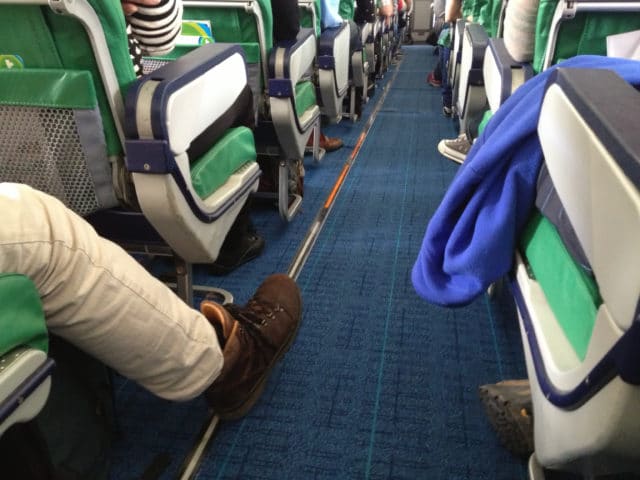Passenger-Related Safety Hazards
The ASRS Directline was the NASA publication for the Aviation Safety Reporting System which sadly is no longer producing articles but I’m pleased that they have offered me permission to reprint some of the best ones. I hope that you will enjoy this article from the ASRS Directline as much as I did.

Passenger-Related Safety Hazards
by Betty Hicks and Rowena Morrison
Reports in the media and popular films frequently leave the impression that the main safety threats to commercial air carrier operations involve bombs, terrorist hijackings, and hazardous cargo. However, reports received by Aviation Safety Reporting System (ASRS) belie some of these notions. Pilot and flight attendant reports to the ASRS indicate that passengers themselves are an unexpected source of many inflight safety problems, ranging from the merely annoying, to those that pose serious interference with crew duties and a potential risk to aircraft structural integrity.
ASRS data is not the only indicator of a serious and growing problem with passenger inflight incidents. A recent issue of a major air carrier’s employee publication noted an almost 200% increase between 1994 and 1995 in reports filed with the company by flight attendants describing interference from passengers. [Endnote 1] The interference included assaulting, threatening, or intimidating crew members performing their inflight duties. During this same period, the number of physical assaults experienced by flight attendants at this carrier increased threefold.

Passenger-related incidents form only a tiny fraction of ASRS database holdings. A recent review of 73 database reports referencing inflight security problems revealed that passengers – drunken, obstreperous, or dangerously uninformed – constituted 23 percent of the reports submitted, equaling the number of incidents involving hazardous materials carried in the cargo hold. Passengers carrying guns, with and without the necessity to be armed, accounted for another 12 percent of these 73 reports. In general, the ASRS passenger-induced safety hazards fell into the following categories:
- Alcohol or drug-related violence;
- Uncooperative or unstable behavior;
- Carriage of hazardous materials and devices on board.
The following discussion presents some thought-provoking – and typical – examples drawn from ASRS data of adverse passenger effects on flight safety. It describes how these incidents were handled, and summarizes reporters’ conclusions about how future occurrences might be prevented, or their impact lessened.
The Case of the Swinging Golfer
A golfer en route to an overseas tournament could be expected to swing – but at passengers and flight crew? As so frequently occurs in cases of obstreperous passengers, this golfer had been too well served, as the British phrase it:
“The passenger had been served several drinks prior to this, [and] was obnoxious, walking around the cabin with a wine bottle and annoying his seat partner…” (#250824)
It was later determined that the passenger had apparently taken a doctor-prescribed sleeping pill or relaxant along with the alcohol. At the initial disturbance, the Captain dispatched the relief pilot to check on the situation. The passenger temporarily calmed down, but the cease-fire was not long-lived. In response to the next disturbance, the Captain sent the Second Officer (a retired Captain), to speak to the golfer. While the Second Officer momentarily had his attention diverted, the golfer hit him in the chin with an uppercut.

The pugilist “was subdued and restrained with airline-issue handcuffs, from which he released himself (or broke) in about 30 minutes.” The relief pilot was recalled to oversee the behavior of the out-of-bounds golfer, “…who was on good behavior for the remainder of the flight.” At the intermediate destination, the golfer was removed from the airplane and sent back to the origination point with two escorts. He was arrested there and permitted one phone call – which he used to call the airline to make reservations to his original overseas destination!
The unlucky Captain of this flight had two recommendations to ASRS and to his airline, based upon this passenger’s antics: (1) have a designated “bouncer” assigned to flights, and in no case send the PIC back to cope with the problem; and (2) provide training in use of the airline’s new-design handcuffs.
A Commotion at Cruise
The pilot reported to ASRS that this female passenger “was OK for the first two hours of the flight…” (#132061) But she became violent at cruise, grabbing a Flight Attendant by the hair and shaking her, and bruising and scratching other passengers. A doctor on board managed to calm the passenger. “The person who boarded her put us all at risk!” protested the reporting pilot, expressing what may be excessive optimism that a Passenger Service Representative could diagnose the future misbehavior of a passenger who appeared calm during boarding.
In similar ASRS reports, crew members suggested better screening of passengers: “I suggest airport police be given the authority to test suspect passengers for intoxication to determine if they are fit for boarding.” “We feel that passengers should be closely observed during the ticketing and boarding process, and not boarded if their behavior is questionable.”
“Oh, Were We Cleared to Two Five Zero?”
“While we began our pushback, a deranged passenger tried to force open the main cabin door.” The relationship between this incident and the late initiation of a descent would appear to fall in the non-sequitur category. Not according to this ASRS report:
“The Flight Service Manager and I were discussing some events concerning the passenger who earlier tried to force open the main cabin door. That event [had] resulted in a one-hour delay, police action, reports, etc. which we were discussing as the Flight Service Manager reviewed the comments in her report with me at the time I failed to begin my descent.
“A few minutes later, while we were still at FL290, the Controller asked, ‘Have you started your descent to flight level two five zero? You were cleared to two five zero several minutes ago. I now need a good descent rate through flight level two seven zero for traffic.’ As I leveled, I asked the Controller if our late descent had caused any problem. ‘Not now,’ was ATC’s curt reply.” (#151533)
Since the flight was still at cruise, well above the altitude at which sterile cockpit procedures would have been initiated, this may have seemed a reasonable time to review the pushback incident. However, assignment of cockpit duties to the co-pilot would have been appropriate before the Captain took himself “out of the loop” for the discussion with the Flight Service Manager.
The Pax with the Aft Attitude
The commuter passenger who figures in the next incident was not hauled off for incarceration, nor was he charged with physically interfering with a crew member in performance of his or her duties. But for sheer obstinance, he was a winner.
“The forward cargo door motor was inoperative, so substantial baggage was placed in the aft cargo compartment. For weight and balance purposes, this required the four rearmost rows of seats to be vacant throughout the flight. All passengers seated in those rows were moved forward prior to taxi. Fifteen minutes after takeoff, while the seat belt sign was still illuminated, our Flight Attendant (FA) called on the intercom and said that one passenger got up and moved to one of the blocked rows.” (#170401)
The Flight Attendant asked the man to move for weight and balance purposes. He refused. She explained again that his moving was necessary for weight and balance compliance. He responded that he was a pilot, and punctuating his statement with four-letter words, announced that he knew better than to accept the necessity to move. Moreover, he challenged, “If the pilots want me to move, they can come back here and make me.” The Flight Attendant then asked for help from the flight deck, but both pilots were too busy with flight duties to leave the cockpit. The Captain later reported to ASRS:
“The Flight Attendant assured us the man was now seated in the blocked rows where there was no one to disturb. I decided to continue to our destination, but wanted to ensure that nothing whatsoever would be done to agitate this individual… Since he indicated he was a pilot, he was aware of the laws and intentionally violated them. He certainly knew the significance of keeping an aircraft loaded within weight and balance parameters. He willfully jeopardized the lives of everyone aboard the aircraft.”
The Flight Attendant added, “When I offered him refreshments he just sat there with his arms folded and would not look at me.”
The crew probably took the best action – no action – during this incident. Any further prodding of the passenger by the crew might have resulted in an altercation and a more serious disruption of the flight. Since the aircraft was apparently still flyable with the passenger in the off-limits seat, continuing to the destination was the least provocative course of action.
“What’s That Smell?”
Not all the inflight passenger problems reported to ASRS were the result of actions by intoxicated or belligerent individuals. There were several instances in which well-behaved but uninformed passengers introduced hazardous carry-on baggage into the cabin. One such incident, reported by a First Officer, involved the discovery by the cabin crew of a malodorous surprise in an overhead bin:
“…A passenger was carrying a compact chain saw (blade and chain removed) in a cardboard box in the overhead bin. The box would not fit upright, so the passenger had set it on its side. This apparently allowed fuel/oil mixture in the engine (tank was empty) to seep out into the box and finally the overhead bin as well. We removed the other articles from the bin (2 coats) and covered the box with a damp blanket to keep down the fumes. Other passengers now started to complain about the fumes, so I went back to investigate. By now a mixture of fuel and water was dripping out of the overhead bin onto a passenger seat… (#225383)
The cabin crew carried the offending box to a rear lavatory and covered it with a damp blanket to stifle the fumes, while air vents and the lavatory drain were opened to increase airflow. The crew then locked the lavatory and increased the airflow through the cabin to dissipate the odor. The passenger who owned the chain saw was described as “very cooperative, maybe even embarrassed.” The final surprise was the passenger’s account of how the chain saw had been brought on board: Prior to this passenger’s initial boarding, “Security told him he could carry it on. Since then he had not had to clear security screening, so nothing more was said to him about it.”

In a similar incident, cabin crew investigating an unusual odor discovered a small leaking camp stove concealed in a knapsack enclosed in an overhead bin. Confusion reigned while the crew tried to sort out the appropriate procedure to follow. The airplane flight manual was ambiguous, so they contacted dispatch, which in turn contacted the Chief Pilot and Fleet Manager for clarification. The Chief Pilot and Fleet Manager disagreed on interpretation of the flight manual, so the hapless crew finally complied with the most conservative procedure – they diverted for landing to remove the leaking camp stove from the aircraft.
“An emergency was declared so as to have assistance readily available should it become needed. Upon arrival at the gate, the Station Manager removed the camp stove and knapsack from the aircraft. The passenger to whom the knapsack belonged was cooperative. He had proceeded through security screening with the nap sack without the stove being detected, despite the fact that the stove was constructed of metal and was stored in a metal box measuring approximately 4 inches by 6 inches by 6 inches. The passenger was unaware that carrying the fuel camp stove on board an aircraft was prohibited.” (#342234)
Of Arms and a ‘Leg’
Flight crews become upset when they are the last to know that they have authorized armed security on board. “Before boarding,” recalled one PIC, “I was told that a [government] VIP was traveling. After the flight was completed, I discovered that the VIP was accompanied by two security personnel. It was then that we realized that we had two armed individuals on the flight, and we had no notification to the flight attendants or to the PIC.”
This violation of the airline’s operations manual caused the Captain to invite the Operations Department to investigate. They found a trail of deteriorating communications.
“The proper forms were filled out. The agents were briefed to inform the Flight Attendants (FAs) that they were armed; they did not do so. The ramp supervisor knew that the VIP’s escorts were armed, and he told our FA that we had ‘two leg passengers in Row 4,’ (‘Leg’ being the curious code word for ‘armed individual.’) Needless to say, no one told us that was the code, so the FA thought he meant, ‘Two passengers with hurt legs.’ The agents did not display their special boarding passes to the FA. Not only that, they did not sit in their assigned Row 4 seats.” (#251326)
The Flight Attendant solicitously asked the two passengers in Row 4 if their legs were OK. They were.

It is a policy at some air carriers that when an armed passenger is admitted to the aircraft, the Passenger Service Representative comes to the cockpit to inform the flight crew of the location of the passenger and that person’s need for carrying the weapon during the flight. When there is more than one armed passenger on board, the Captain also makes sure that the armed individuals are introduced to each other, so that neither will be surprised by the sight of another weapon-carrying passenger. The use of direct, clear communication – privately delivered to the appropriate parties – generally gets the information across.
Other Passenger Problems
The balance of reports regarding other passenger problems were mostly unique incidents. They included gate agents who permitted passenger boarding before flight attendants were on the airplane, an apparently alcohol-impaired passenger blocking an emergency exit, and a brazen passenger retrieving his own bags from a commuter baggage compartment.
Intoxicated passengers, disorderly behavior, undeclared hazardous materials in carry-on baggage – these and other problems identified in ASRS data pose potential threats to the safe operation of aircraft flights. To safely manage the outcome of these incidents, pilots need to use lots of diplomacy, apply Crew Resource Management skills, and operate strictly according to company procedures. One Captain summed it up nicely:
“In order to guarantee compliance with the numerous, complex aviation regulations, pilots need to be well informed, cautiously skeptical, and they need to document their actions.”
[Endnote 1] “American Will Not Tolerate Abuse of its Employees,” American Airlines Flagship News, Vol. 52, No. 19, September 30, 1996, p. 1.
I hoped you enjoyed the article. I wonder how many of you noticed the lack of modern references: no mobile phones and no restrictions on bringing liquids into the flight. I suspect that the chain saw full of fuel probably gave it away. The article itself was published in ASRS Directline in March 1997 and I have to admit, I thought it aged spectacularly well other than that.
Go ahead and tell me in the comments what other dated references I missed.








I’ve always thought that soaring across the sky in a commercial jet would be a MUCH more enjoyable experience if it were not for all those &%$#@ passengers.
I had one of the later happen to me last year – I was boarding a flight leaving Houston Hobby and we were seated on the plane without cabin crew or flight crew. The cabin crew came soon, but we waited an hour for flight crew.
The problem wasn’t so much the delay but that this was the middle of summer with outside temperatures of nearly 100 F and everything was off except the lights; the airplane was a sweatbox when we boarded and got worse as we waited… I’m surprised we didn’t have any medical issues!